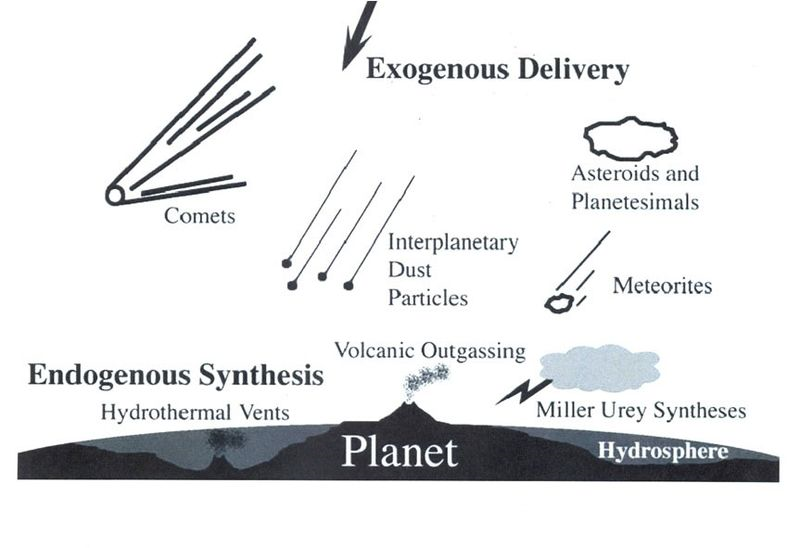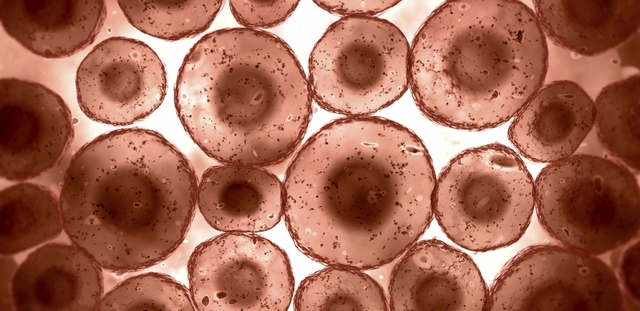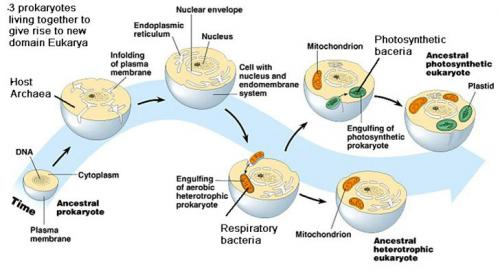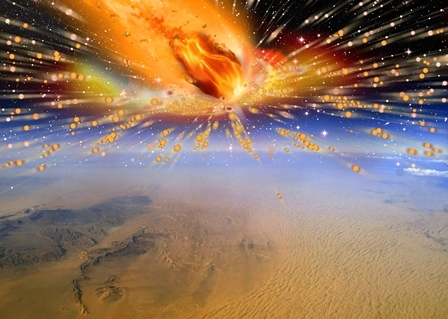It looks like you're using an Ad Blocker.
Please white-list or disable AboveTopSecret.com in your ad-blocking tool.
Thank you.
Some features of ATS will be disabled while you continue to use an ad-blocker.
"How Did Life Begin on Earth?" --A New Theory Embraces the Cosmic through Geological, Chemical, an
page: 1share:
“When the Earth formed some 4.5 billion years ago, it was a sterile planet inhospitable to living organisms,” said Sankar Chatterjee, Horn Professor of Geosciences and curator of paleontology at the Museum of Texas Tech University. “It was a seething cauldron of erupting volcanoes, raining meteors and hot, noxious gasses. One billion years later, it was a placid, watery planet teeming with microbial life – the ancestors to all living things.”
OK basically he is saying that that meteors that once struck the earth not only brought the right ingredients needed to start building life they also created the right habitats by punching holes through the crust creating those geothermal vents.
Us being in the goldilocks zone where water remains water those craters filled with water first. Imagine each crater as its own test tube. The thermal vents as its heating source. Those thermal vents also added in the right mixture of elements to the process as well.
“For may years, the debate on the origins of life centered on the chemical evolution of living cells from organic molecules by natural processes. Chatterjee said life began in four steps of increasing complexity – cosmic, geological, chemical and biological. By studying three sites containing the world’s oldest fossils, he believes he knows how the first single-celled organisms formed in hydrothermal crater basins.
“The dual origin of the ‘RNA/protein’ world is more plausible in the vent environments than the popular ‘RNA world,’” he said. “RNA molecules are very unstable. In vent environments, they would decompose quickly. Some catalysts, such as simple proteins, were necessary for primitive RNA to replicate and metabolize. On the other hand, amino acids, from which proteins are made, are easier to make than RNA components.”
The question remains how loose RNA and protein material floating in this soup protected itself in a membrane. Chatterjee believes University of California professor David Deamer’s hypothesis that membranous material existed in the primordial soup. Deamer isolated fatty acid vesicles from the Murchison meteorite that fell in 1969 in Australia. The cosmic fatty bubbles extracted from the meteorite mimic cell membranes.
“Meteorites brought this fatty lipid material to early Earth,” Chatterjee said. “This fatty lipid material floated on top of the water surface of crater basins but moved to the bottom by convection currents. At some point in this process during the course of millions of years, this fatty membrane could have encapsulated simple RNA and proteins together like a soap bubble. The RNA and protein molecules begin interacting and communicating. Eventually RNA gave way to DNA – a much more stable compound – and with the development of the genetic code, the first cells divided.”
the daily galaxy
Once those crater filled with water along with other materials brought by other meteors the environment is ready and the process begins. One of the main ingredients to this is the fatty lipids because other scientists have shown they were probably instrumental in forming the first cells because they form something like a cell membrane.
Here is how some of that may have worked.
Chemists show life on Earth was not a fluke
How life came about from inanimate sets of chemicals is still a mystery. While we may never be certain which chemicals existed on prebiotic Earth, we can study the biomolecules we have today to give us clues about what happened three billion years ago.
Now scientists have used a set of these biomolecules to show one way in which life might have started. They found that these molecular machines, which exist in living cells today, don’t do much on their own. But as soon as they add fatty chemicals, which form a primitive version of a cell membrane, it got the chemicals close enough to react in a highly specific manner.
This form of self-organisation is remarkable, and figuring out how it happens may hold the key to understanding life on earth formed and perhaps how it might form on other planets.
The 1987 Nobel Prize in Chemistry was given to chemists for showing how complex molecules can perform very precise functions. One of the behaviours of these molecules is called self-organisation, where different chemicals come together because of the many forces acting on them and become a molecular machine capable of even more complex tasks. Each living cell is full of these molecular machines.
Pasquale Stano at the University of Roma Tre and his colleagues were interested in using this knowledge to probe the origins of life. To make things simple, they chose an assembly that produces proteins. This assembly consists of 83 different molecules including DNA, which was programmed to produce a special green fluorescent protein (GFP) that could be observed under a confocal microscope.
The conversation
Back to the main article.
The final stage – the biological stage – represents the origin of replicating cells as they began to store, process and transmit genetic information to their daughter cells, Chatterjee said. Infinite combinations took place, and countless numbers must have failed to function before the secret of replication was broken and the proper selection occurred.
“These self-sustaining first cells were capable of Darwinian evolution,” he said. “The emergence of the first cells on the early Earth was the culmination of a long history of prior chemical, geological and cosmic processes.”
the daily galaxy
That part is a little harder for me to explain but it is pretty common theory of how life evolved from that point and is found in many theory’s.
He has built on other plausible theorems adding in more variables.
Chatterjee said. However, he suggested an experiment to recreate the ancient prebiotic world and support or refute his theory. “If future experiments with membrane-bound RNA viruses and prions result in the creation of a synthetic protocell, it may reflect the plausible pathways for the emergence of life on early Earth,”
I think his theory is worth testing it would be great if they get some positive results.
I see the beginning of earth as a giant testing ground that had billions of years to churn different scenarios out. For me it only makes sense that eventually the right conditions would have been met to create life. The planet wasn’t placid it was alive in its own way with meteor strikes, thermal vents, and seismic activity. Proof for that is we are here I would just like to see science recreate it.
edit on 30-10-2013 by
Grimpachi because: (no reason given)
reply to post by Grimpachi
Meanwhile, back in English class...hahaha.
Seriously, I didn't understand any of that. I don't have a biology degree, I wasn't a valedictorian, and I most certainly didn't prove a stellar study in my chemistry classes. Fascination stuff, yes...but so is quantum physics.
Can we get a Dummies version? Please? For a cookie? Never mind, I don't have any cookies. But I can ask really nicely and bat my eyes...
Meanwhile, back in English class...hahaha.
Seriously, I didn't understand any of that. I don't have a biology degree, I wasn't a valedictorian, and I most certainly didn't prove a stellar study in my chemistry classes. Fascination stuff, yes...but so is quantum physics.
Can we get a Dummies version? Please? For a cookie? Never mind, I don't have any cookies. But I can ask really nicely and bat my eyes...
reply to post by Grimpachi
Nice thread..and an Interesting read.
look forward to following this.
s&f
Nice thread..and an Interesting read.
look forward to following this.
s&f
see this theory that comets and meteors brought life to earth has got to have some flaws,cause if space was that crowded back then for them to be
hitting our planet that much then surely the rest of the planets were being bombarded too?so why only earth retaind the water suppously brought from
comets and no where else?
i,m not convinced by this goldielocks zone either cause of the huge difference in sizes by the hosts stars,even the slightest calculation being out will give them false facts,come on only a few years ago Enceladus was a dead moon,now?
i,m not convinced by this goldielocks zone either cause of the huge difference in sizes by the hosts stars,even the slightest calculation being out will give them false facts,come on only a few years ago Enceladus was a dead moon,now?
reply to post by AfterInfinity
Yeah it’s a lot I know. I thought about trying to give notes then I realized I would screw it up because there is a lot there that I am struggling with but give me a few minutes and I will try to sum it up and add it to the OP.
I am working with a real small screen right now so it takes a little longer for me.
edit to add
Alright I did my best to give notes. I think the main thing to consider here is it takes into account many driving forces. Such as meteors bringing the building blocks and creating the proper landscape test tubes along with thermal vents for heating the primordial soup.
Yeah it’s a lot I know. I thought about trying to give notes then I realized I would screw it up because there is a lot there that I am struggling with but give me a few minutes and I will try to sum it up and add it to the OP.
I am working with a real small screen right now so it takes a little longer for me.
edit to add
Alright I did my best to give notes. I think the main thing to consider here is it takes into account many driving forces. Such as meteors bringing the building blocks and creating the proper landscape test tubes along with thermal vents for heating the primordial soup.
edit on 30-10-2013
by Grimpachi because: (no reason given)
Some posters, I'm learning to Star and Flag on general principle.
S+F!
Well done. Interesting fun read.
S+F!
Well done. Interesting fun read.
One step closer to saying ....
Getting warmer.
Very interesting star and flag!!
Getting warmer.
Very interesting star and flag!!
reply to post by AfterInfinity
Alright I added to it. Thanks for pointing that out. I should have done that from the get go.
Alright I added to it. Thanks for pointing that out. I should have done that from the get go.
Organization seems inherent at all scales of the universe. I see life as the culmination of macro scale organization creating atom by atom beginning
with the least dense to creating denser atoms in a perfect sequence of events and then the atoms themselves doing their own organization to produce an
even more complex form.
Increasing complexity in every new order. Life may have happened exactly how this thread says it happened, but I believe it was inevitable. Matter has a tendency to organize itself into more complex forms that stand alone as their own unit.
Increasing complexity in every new order. Life may have happened exactly how this thread says it happened, but I believe it was inevitable. Matter has a tendency to organize itself into more complex forms that stand alone as their own unit.
There is a mystery in the experiment, though.
As if something else is operating behind the curtains of the presently known physical laws and stacking the odds in favor of life.
But remarkably, five in every 1,000 such liposomes had all 83 of the molecules needed to produce a protein. These liposomes produced large amount of GFP and glowed green under a microscope. Computer calculations reveal that even by chance, five liposomes in 1,000 could not have trapped all 83 molecules of the assembly. Their calculated probability for even one such liposome to form is essentially zero. The fact that any such liposomes formed and that GFP was produced means something quite unique is happening. Stano and his colleagues do not yet understand why this happened.
As if something else is operating behind the curtains of the presently known physical laws and stacking the odds in favor of life.
This was discussed in the "Life may have begun on Mars" threads on here.
During that discussion there was an article that said
"RNA needs to be coaxed into shape by "templating" atoms at the crystalline surfaces of minerals.
The minerals most effective at templating RNA would have dissolved in the oceans of the early Earth, but would have been more abundant on Mars, according to Prof Benner"
Source: www.bbc.co.uk...
The thought of quantum level manifestations ( lattices on the crystalline surface of minerals) physically providing a "template" for one of the core building blocks of life blows my mind.
Obviously the (almost infinite) scale and time of the universe provides a rich playground for such interactions to occur but it certainly helped life on Earth that a blueprint (some sort of pervasive multidimensional quantum shape?) seems to manifest itself at the smallest scale in all matter and energies.
God, Source Code or just the pre requisites of a hologram...something causes it and it's probably a lot more interesting than the options presented above.
During that discussion there was an article that said
"RNA needs to be coaxed into shape by "templating" atoms at the crystalline surfaces of minerals.
The minerals most effective at templating RNA would have dissolved in the oceans of the early Earth, but would have been more abundant on Mars, according to Prof Benner"
Source: www.bbc.co.uk...
The thought of quantum level manifestations ( lattices on the crystalline surface of minerals) physically providing a "template" for one of the core building blocks of life blows my mind.
Obviously the (almost infinite) scale and time of the universe provides a rich playground for such interactions to occur but it certainly helped life on Earth that a blueprint (some sort of pervasive multidimensional quantum shape?) seems to manifest itself at the smallest scale in all matter and energies.
God, Source Code or just the pre requisites of a hologram...something causes it and it's probably a lot more interesting than the options presented above.
edit on 31-10-2013 by Jukiodone because: (no reason given)
edit on 31-10-2013 by Jukiodone because: (no reason
given)
reply to post by Grimpachi
I have to wonder how much thought is given to the actual lineage of all that
has to happen with a hypothesis such as this ? I mean meteors and/or comets
striking the earth back then instead of now. And when did earth develope an
atmosphere ?
Respectfully
I have to wonder how much thought is given to the actual lineage of all that
has to happen with a hypothesis such as this ? I mean meteors and/or comets
striking the earth back then instead of now. And when did earth develope an
atmosphere ?
Respectfully
reply to post by randyvs
About 4.1 billion years ago, the Earth’s surface — or crust — began to cool and stabilize, creating the solid surface with its rocky terrain. Clouds formed as the Earth began to cool, producing enormous volumes of rainwater that formed the oceans. We are still pounded by meteors each day estimates for the mass of material that falls on earth each year range from 37,000-78,000 tons. Most of this mass would come from dust-sized particles. Less common would be comets but that is good news because they can cause mass extinctions here is a quote from a recent article on comets.
About 4.1 billion years ago, the Earth’s surface — or crust — began to cool and stabilize, creating the solid surface with its rocky terrain. Clouds formed as the Earth began to cool, producing enormous volumes of rainwater that formed the oceans. We are still pounded by meteors each day estimates for the mass of material that falls on earth each year range from 37,000-78,000 tons. Most of this mass would come from dust-sized particles. Less common would be comets but that is good news because they can cause mass extinctions here is a quote from a recent article on comets.
science direct
The discovery has not only provided the first definitive proof of a comet striking Earth, millions of years ago, but it could also help us to unlock, in the future, the secrets of the formation of our solar system.
“Comets always visit our skies – they’re these dirty snowballs of ice mixed with dust – but never before in history has material from a comet ever been found on Earth,” says Professor David Block of Wits University.
The comet entered Earth’s atmosphere above Egypt about 28 million years ago. As it entered the atmosphere, it exploded, heating up the sand beneath it to a temperature of about 2 000 degrees Celsius, and resulting in the formation of a huge amount of yellow silica glass which lies scattered over a 6 000 square kilometer area in the Sahara. A magnificent specimen of the glass, polished by ancient jewellers, is found in Tutankhamun's brooch with its striking yellow-brown scarab.
link
Everybody seems to always forget or ignore that at a certain level of existence, time is not necessarily linear, and that subatomic and atomic
structures can "move" relatively freely into the past as well as the future. So the whole idea of looking for some kind of genesis, following the
notion that life somehow developed or evolved out of a combination of chemicals (or was created by God) is kind of based on a false assumption.
There's no need for such a thing as a beginning.
reply to post by Blue Shift
Searching for our origins is part of being human. Early man tried to explain them through stories they didn’t have the tools we have now I think we will always be looking for the answers to our origins until we have something concrete.
There's no need for such a thing as a beginning.
Searching for our origins is part of being human. Early man tried to explain them through stories they didn’t have the tools we have now I think we will always be looking for the answers to our origins until we have something concrete.
reply to post by Grimpachi
Thank you for the response.
Alright, so if I were to say, the lineage is linked to natural processes in the
order of their occurrence with-in the captured system of Earth.
Would that be accurate ?
SnF
Thank you for the response.
Alright, so if I were to say, the lineage is linked to natural processes in the
order of their occurrence with-in the captured system of Earth.
Would that be accurate ?
SnF
reply to post by randyvs
Can you rephrase what you just said? Maybe expand a bit on it because I don’t really follow.
Can you rephrase what you just said? Maybe expand a bit on it because I don’t really follow.
reply to post by Grimpachi
I'm trying to make myself a path to understanding how these speculations
are believable. So I need to find a reason for the succession of the events
as they happened. Because if one part in any of it is out of turn. Wouldn't
everything fail ?
I'm sorry if I'm vague.
Say the timing of the meteors for example was off a couple billion years ?
I'm trying to make myself a path to understanding how these speculations
are believable. So I need to find a reason for the succession of the events
as they happened. Because if one part in any of it is out of turn. Wouldn't
everything fail ?
I'm sorry if I'm vague.
Say the timing of the meteors for example was off a couple billion years ?
edit on 31-10-2013 by randyvs because: (no reason given)
reply to post by randyvs
OK I see what you are asking now.
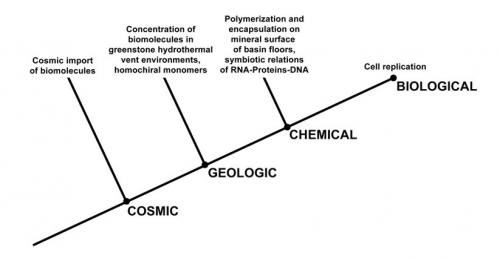
I didn’t want to quote the entire article because it would go against T&C but this graph shows the order of events proposed. He believes it happened in 4 stages as represented above.
I think the first three are fairly easy to accept it is the fourth that still has a hurdle to overcome.
The bridge between the 3rd and 4th is linked to the second article I linked talking about how fatty lipids have a tendency to encapsulate. Those lipids are thought to have come from meteorites.
I consider that where life actually got its first spark.
I hope that answers your question if not I will try harder.
OK I see what you are asking now.

I didn’t want to quote the entire article because it would go against T&C but this graph shows the order of events proposed. He believes it happened in 4 stages as represented above.
I think the first three are fairly easy to accept it is the fourth that still has a hurdle to overcome.
The bridge between the 3rd and 4th is linked to the second article I linked talking about how fatty lipids have a tendency to encapsulate. Those lipids are thought to have come from meteorites.
“Meteorites brought this fatty lipid material to early Earth,” Chatterjee said. “This fatty lipid material floated on top of the water surface of crater basins but moved to the bottom by convection currents. At some point in this process during the course of millions of years, this fatty membrane could have encapsulated simple RNA and proteins together like a soap bubble. The RNA and protein molecules begin interacting and communicating. Eventually RNA gave way to DNA – a much more stable compound – and with the development of the genetic code, the first cells divided.”
I consider that where life actually got its first spark.
I hope that answers your question if not I will try harder.
new topics
-
whistleblower Captain Bill Uhouse on the Kingman UFO recovery
Aliens and UFOs: 2 hours ago -
1980s Arcade
General Chit Chat: 4 hours ago -
Deadpool and Wolverine
Movies: 5 hours ago -
Teenager makes chess history becoming the youngest challenger for the world championship crown
Other Current Events: 6 hours ago -
CIA botched its handling of sexual assault allegations, House intel report says
Breaking Alternative News: 7 hours ago -
Lawsuit Seeks to ‘Ban the Jab’ in Florida
Diseases and Pandemics: 9 hours ago -
Starburst galaxy M82 - Webb Vs Hubble
Space Exploration: 11 hours ago -
15 Unhealthiest Sodas On The Market
Health & Wellness: 11 hours ago
top topics
-
Lawsuit Seeks to ‘Ban the Jab’ in Florida
Diseases and Pandemics: 9 hours ago, 20 flags -
Starburst galaxy M82 - Webb Vs Hubble
Space Exploration: 11 hours ago, 11 flags -
CIA botched its handling of sexual assault allegations, House intel report says
Breaking Alternative News: 7 hours ago, 8 flags -
The Superstition of Full Moons Filling Hospitals Turns Out To Be True!
Medical Issues & Conspiracies: 13 hours ago, 8 flags -
whistleblower Captain Bill Uhouse on the Kingman UFO recovery
Aliens and UFOs: 2 hours ago, 6 flags -
IDF Intel Chief Resigns Over Hamas attack
Middle East Issues: 16 hours ago, 6 flags -
15 Unhealthiest Sodas On The Market
Health & Wellness: 11 hours ago, 5 flags -
It takes One to Be; Two to Tango; Three to Create.
Philosophy and Metaphysics: 17 hours ago, 4 flags -
Teenager makes chess history becoming the youngest challenger for the world championship crown
Other Current Events: 6 hours ago, 3 flags -
Deadpool and Wolverine
Movies: 5 hours ago, 3 flags
active topics
-
How ageing is" immune deficiency"
Medical Issues & Conspiracies • 21 • : RookQueen2 -
New whistleblower Jason Sands speaks on Twitter Spaces last night.
Aliens and UFOs • 37 • : baablacksheep1 -
1980s Arcade
General Chit Chat • 6 • : tarantulabite1 -
Europe declares war on Russia?
World War Three • 58 • : 777Vader -
-@TH3WH17ERABB17- -Q- ---TIME TO SHOW THE WORLD--- -Part- --44--
Dissecting Disinformation • 605 • : Ektar -
Teenager makes chess history becoming the youngest challenger for the world championship crown
Other Current Events • 3 • : Skinnerbot -
So you don't believe in the devil
Paranormal Studies • 143 • : burritocat -
whistleblower Captain Bill Uhouse on the Kingman UFO recovery
Aliens and UFOs • 5 • : budzprime69 -
Lawsuit Seeks to ‘Ban the Jab’ in Florida
Diseases and Pandemics • 21 • : StoutBroux -
British TV Presenter Refuses To Use Guest's Preferred Pronouns
Education and Media • 107 • : WakeUpBeer

